This Dr. Axe content is medically reviewed or fact checked to ensure factually accurate information.
With strict editorial sourcing guidelines, we only link to academic research institutions, reputable media sites and, when research is available, medically peer-reviewed studies. Note that the numbers in parentheses (1, 2, etc.) are clickable links to these studies.
The information in our articles is NOT intended to replace a one-on-one relationship with a qualified health care professional and is not intended as medical advice.
This article is based on scientific evidence, written by experts and fact checked by our trained editorial staff. Note that the numbers in parentheses (1, 2, etc.) are clickable links to medically peer-reviewed studies.
Our team includes licensed nutritionists and dietitians, certified health education specialists, as well as certified strength and conditioning specialists, personal trainers and corrective exercise specialists. Our team aims to be not only thorough with its research, but also objective and unbiased.
The information in our articles is NOT intended to replace a one-on-one relationship with a qualified health care professional and is not intended as medical advice.
TRX Workout: Best Exercises for Beginners
May 17, 2023
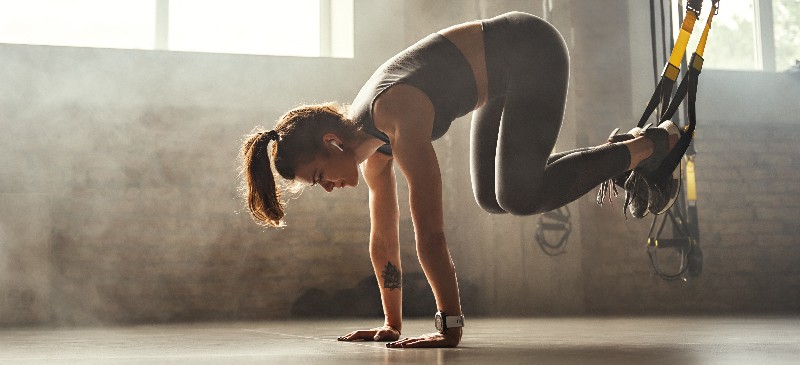
While TRX training is popular among elite athletes, models, members of the military and Hollywood A-listers alike, the truth is it’s a great mode of exercise for almost anyone, including people who are just getting started. In other words, no pre-existing six-pack is required to give this training style a try.
So let’s get down to it. What exactly is a TRX suspension trainer? And what’s the best way to incorporate TRX workouts into your fitness routine? Let’s take a look …
What Is TRX?
If you’re bored with dumbbells, exercise bands and burpees, the TRX suspension trainer is a great way to mix things up and challenge your muscles and proprioception in new ways. With TRX exercises, you can change the difficulty and resistance by simply changing your body position. In fact, TRX coined the phrase, “Make your body your machine.”
You can complete an entire whole-body workout using the TRX suspension trainer or you can mix it into your current fitness routine to challenge your stabilizer muscles and balance.
So what is the TRX workout and how does it work? The TRX suspension trainer consists of two adjustable main straps, handles and foot cradles. These straps are connected to a specific anchor, something you can install in your home or even use outside on trees, as long as the anchor is properly attached.
A TRX suspension trainer is a portable, economic piece of exercise equipment that leverages gravity and your own weight to perform hundreds of different bodyweight exercises.
TRX suspension trainer exercises are broken down into specific movement categories. Here they are, along with some common TRX exercises for each movement category:
- Push (TRX Chest Press, Pushups, Triceps Press)
- Pull (TRX Low Row, Biceps Curl, Inverted Row)
- Plank (TRX Plank, Mountain Climbers, Crunches)
- Rotate (TRX Rotational Ward, Power Pull, Oblique Crunch)
- Lunge (TRX Split Squat, Step Back Lunge, Balance Lunge)
- Squat (TRX Hamstring Curl, Squat, Squat Jump)
History of TRX
Stationed in Southeast Asia in 1997 and far away from a gym with weights, Navy SEAL Randy Hetrick created the first version of what would become known as TRX using just a jiu-jitsu belt and parachute webbing.
With refinement, it became the suspension trainer used around the world.
So what does TRX stand for, anyway? Sometimes referred to as total resistance exercises, TRX suspension training develops:
- Strength
- Balance
- Flexibility
- Core stability
“Can you build muscle with a TRX?” That’s a source of some debate, so let’s take a look at the research.
Benefits
1. It’s a great option for older adults
As we age, we naturally start losing muscle mass, a change that leads to more trouble getting around, p0or balance and less strength. When you put that all together, this decreased mobility results in a huge quality of life issue that often leads to less independence and happiness.
But when German researchers at the Institute of Movement and Sport Gerontology put older folks on a modified TRX regimen, promising results emerged. The first, and this is a biggie, is compliance. With so many get-fit-in-30-day gimmicks out there, it can be hard to sell moderation and common sense. But in this small study, 85 percent of participants stuck with the TRX program, including 91 percent who said they were motivated to continue with the program.
Using a TRX program adapted for older adults, participants focused on strengthening the core while working on bodyweight rows, chest presses, tricep presses and squats. According to the study, all participants noted positive effects whereas strength gains were the most.
2. It works
The American Council on Exercise commissioned a study to investigate the benefits of TRX and found benefits after just one 60-minute TRX training session, with steady improvements over an eight-week TRX training program.
The overall purpose of this study was twofold. Researchers initially set out to quantify the acute cardiovascular and metabolic responses to a single session of TRX Suspension Training. Part two involved investigating the effectiveness of an 8-week TRX program in relation to improving the following areas of fitness:
- Cardiorespiratory
- Muscular
- Neuromotor
- Flexibility
- Improving cardiometabolic risk factors
Looking at acute impacts of one 60-minute TRX class, researchers found participants burned an average of almost 400 calories per session.
The results of the eight-week training blocks are promising, too. This time, participants took part in three TRX training sessions a week for eight weeks.
Participants experienced these perks in the form of significantly decreased:
- Waist circumference
- Body-fat percentage
- Resting systolic and diastolic blood pressure
- Resting diastolic blood pressure
Strength gains signified improved muscle strength and endurance. The biggest gains occurred in the following areas, with significant increases in:
- 1 repetition maximum leg press
- 1 repetition maximum bench press
- Curl up and push-up tests
“This is perhaps what struck me most,” says study author Lance Dalleck, PhD, associate professor of exercise and sports science at Western State Colorado University. “These changes in muscular fitness, if they are maintained long-term, have been linked to the prevention of cardiovascular disease, diabetes and mortality.”
Other takeaways from the ACE study:
- Prehypertensive exercisers enjoyed up to a 12-point drop in blood pressure, something Dr. Dalleck called “more dramatic results than are typically seen with traditional aerobic exercise.”
- TRX Suspension Training is 86 percent “clinically beneficial in improving full 30-year cardiovascular disease risk.”
3. It gives your a bump of T without all of the stress.
Low testosterone is an issue plaguing American men and women, driving down libido, energy, muscle mass and more.
However, a small 2011 study suggests suspension training may serve as a way to increase testosterone levels without causing a dramatic spike in the stress hormone cortisol.
A moderate intensity suspension training workout using 30-second intervals followed by 60-second rest periods resulted in a positive anabolic profile lasting at least two hours after the workout.
4. It may activate muscles better than traditional lifting
A 2018 review study published in Sports Biomechanics found that that the instability of strength training activated in suspension training versus traditional lifting results in greater muscle activation in many cases.
This was especially true in TRX suspension for pushups, plank and hamstring curls.
5. It’s a great way to mix up your workouts to keep you interested in working out
In 2014, Spanish researchers looked at healthy men with little resistance training experience. Half of the men undertook a more traditional resistance training approach using weight machines, barbells and free weights. The other half used the TRX suspension trainers and Bosu balls to challenge stability more.
Researchers highlight the key points, mainly, that both training circuits produced similar results. The takeaway? Do what you love — or a mix of both — to keep your workout fresh and something you want to stick to.
6. It’ll improve your water game
In a study looking at female synchronized swimmers who committed to two TRX land trainings per week for six months, researchers found improved strength in most core parameters.
This suggests that using TRX can improve your core strength in the water, too, promoting improved movement and reducing the risk of injury. If you love the pool to enjoy the many benefits of swimming, consider adding gentle, beginner TRX land training to your weekly workouts.
7. It costs less and reduces clutter
Let’s face it. Those big old clunky exercise machines often wind up dusty in the basement or as a convenient place to hang laundry. TRX equipment is more affordable than higher-end, bulky machines and uses way less space.
Plus, the suspension straps travel well, meaning you could even take them with you for a workout in the park, assuming you’re using a reliable anchor.
TRX Workout
As a certified personal trainer through the National Academy of Sports Medicine and Level 1 TRX instructor, I like to incorporate some TRX suspension training into every workout. Usually a “mash up” of TRX, agility and balance work and traditional strength training, TRX offers a more unstable base to challenge your core and stabilizing muscles in ways unique to lifting on machines or with free weights.
But this is important: A TRX workout routine circuit must be catered to your current ability level and involve some common sense. If you aren’t able to hold a plank using good form on the floor, do not attempt to do a TRX plank, which is even more difficult.
However, there are appropriate TRX exercises for beginners, including older adults. The key is for the user (or their certified personal trainer) to understand how to properly use the TRX system.
Here are six core TRX exercises. Aim for two sets of 12 to 15 reps. Couple with a yoga workout or do before cardio, for example, and aim for two to three workouts per week.
1. TRX Low Row
Adjustment: Fully shortened
Position: Stand facing anchor
Start: Pull shoulders down and back, bend elbows, palms facing, hands beside chest, walk feet toward anchor point until there’s a squeeze in the back.
Movement: Lower body down until arms are fully extended, maintain plank.
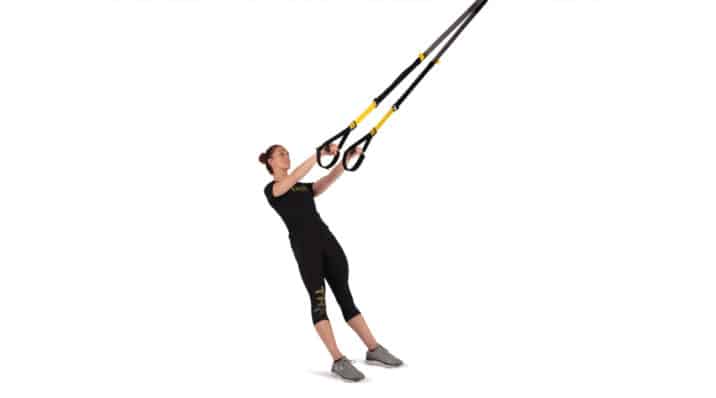
Return: Pull body toward anchor point by driving elbow back beside body.

2. TRX Power Pull
Adjustment: Mid-length, single handle mode
Position: Stand facing anchor
Start: Hand beside chest, free hand reaches up TRX main strap toward anchor point
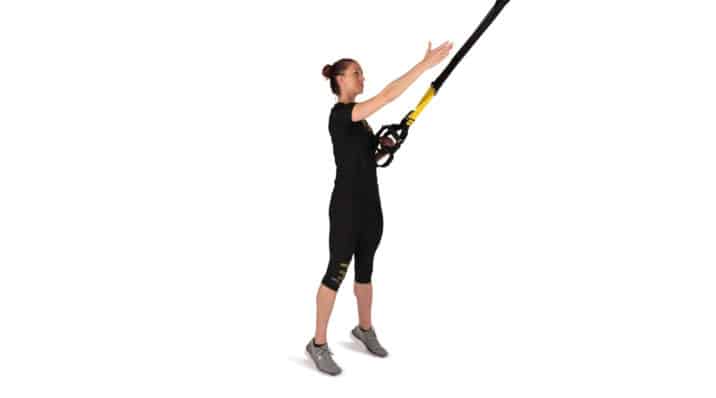
Movement: Move in a circular motion, rotating free arm toward the ground while extending working arm.
Return: Drive working elbow straight back while rotating free arm up toward anchor point.

3. TRX Squat
Adjustment: Mid-length
Position: Stand facing anchor
Start: Stack elbows under shoulders, feet hip-width apart.
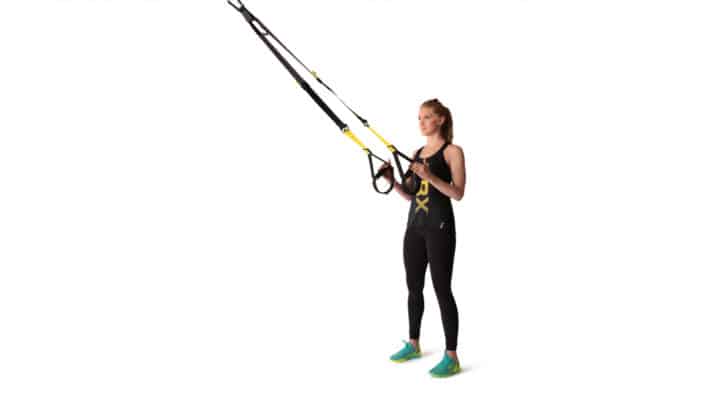
Movement: Lower hips down and back, weight in heels
Return: Drive through heels, squeeze glutes, lift chest
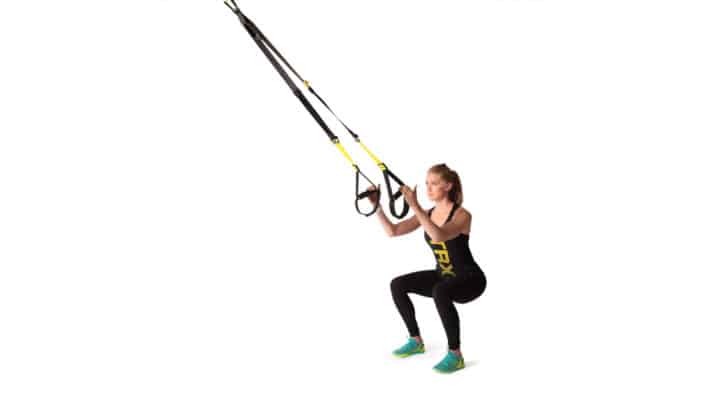
4. TRX Step Back Lunge
Adjustment: Mid-length
Position: Stand facing anchor
Start: Stack elbows under shoulders, center one leg to anchor point, lift opposite leg to 90 degrees at the knee and hip
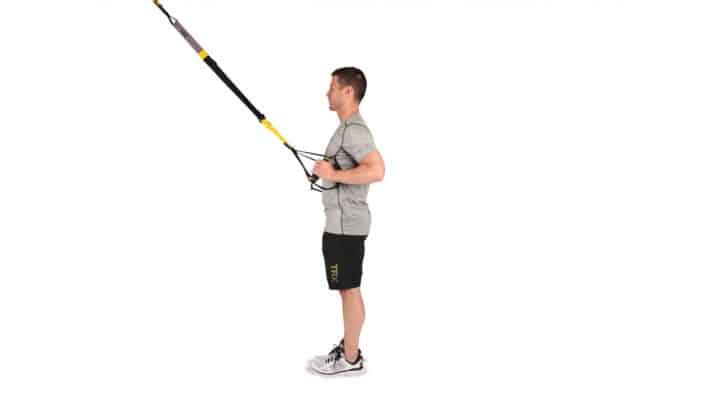
Movement: Drive lifted leg back, touch foot to the ground and lower knee
Return: Drive through mid-foot and heel of grounded leg, extend hips, lift chest, eyes forward, return to full standing position, feet parallel
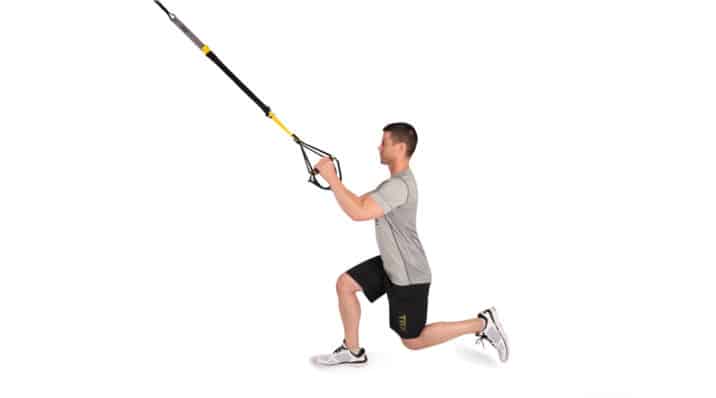
5. TRX Y Fly
Adjustment: Mid-length
Position: Stand facing anchor
Start: Offset foot stance, arms pulled back overhead into a “Y” position, tension on the TRX Suspension Trainer, palms forward

Movement: Lower body, keeping arms straight, return to start position by slowly lowering arms
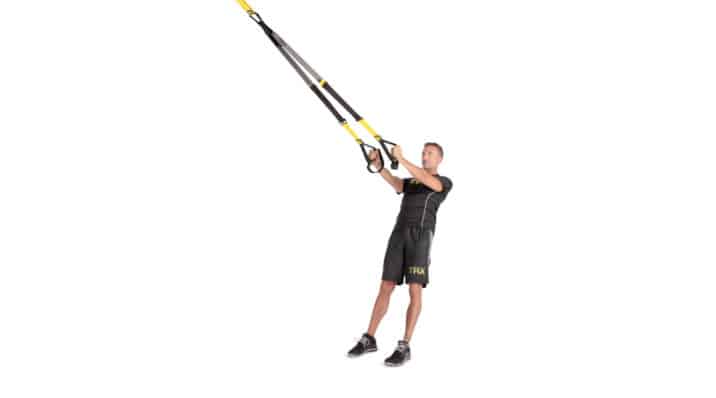
Return: Return to start position by driving knuckles back
6. TRX Hamstring Curl
Adjustment: Mid calf
Position: Ground facing anchor
Start: Position feet under anchor point (arms at sides pressing into ground)
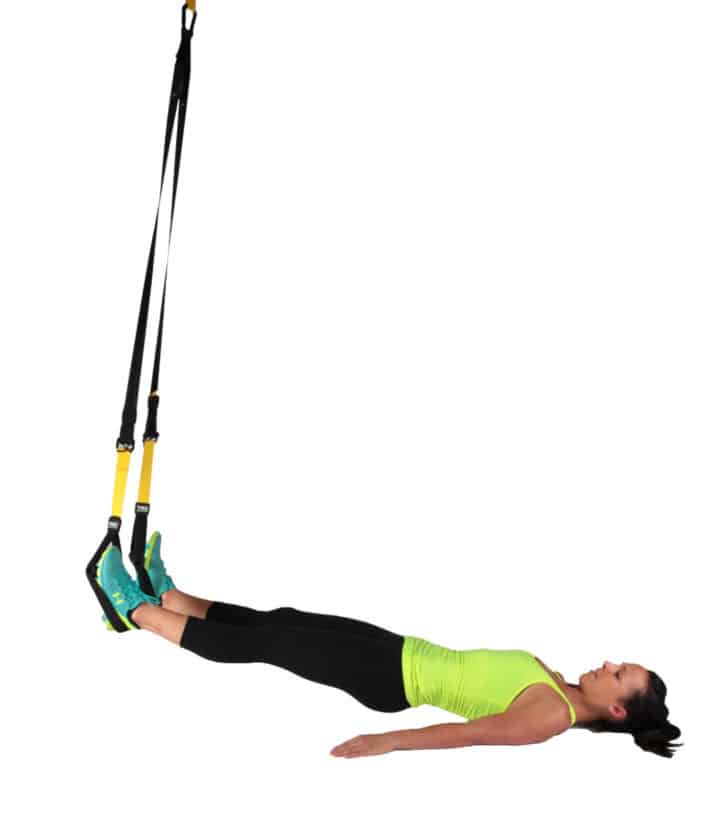
Movement: Pull toes towards body, drive heels down, pull knees over hips, lift hips to form straight line from knees to shoulders
Return: Lower hips toward ground with control, keep knees over hips, extend legs back toward anchor point, leave slight bend in knees at the end of the movement
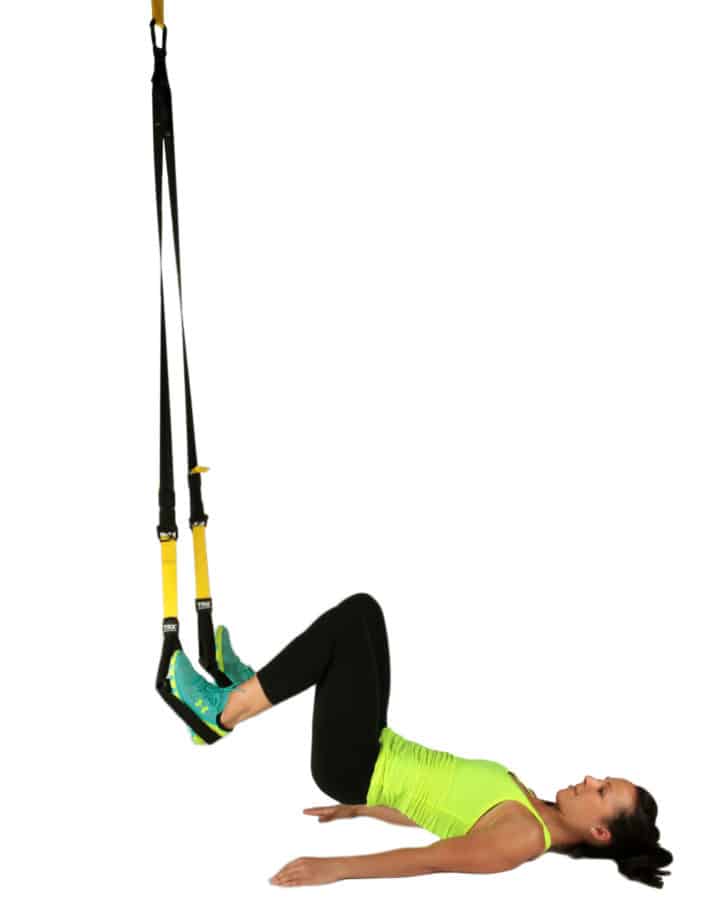
TRX Workouts for Older Adults
And although many pro athletes use TRX for intense training, the truth is TRX also offers more gentle strength builders that are perfect for older folks just getting started. Let’s take a look at some options …
Precautions
How do you mount TRX straps? This is important. You do it by using TRX mounting equipment and following the directions to a T. Mounting TRX straps too high can result in the user wildly swinging, increasing the risk of injury for the person on the straps (or those around her).
Another important note: The beauty of TRX is that it offers modifications to properly work beginners and veteran exercisers alike. But hopping into TRX exercises too soon before you’re ready could increase your risk of injury, so look for a certified personal trainer with a bachelor’s or master’s degree in exercise science to keep your best interests in mind.
Final Thoughts
- TRX is a popular suspension training system that focuses on improving one’s strength, balance, flexibility and core stability.
- TRX training creates instability, which can work your core and stabilizer muscles in different ways compared to traditional weight machines, and dumbbell and barbell training.
- Several studies highlight TRX training’s ability to improve core strength, balance, waist circumference, body-fat percentage, blood pressure and more.
- TRX can be a great tool for beginner exercises and older adults, but should be done under supervision of a personal or group fitness training with a bachelor’s or master’s degree in exercise science or a related degree.
- Properly mounting your TRX and not performing TRX exercises beyond your current fitness levels are crucial components of avoiding injury.

